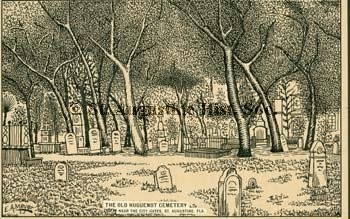Huguenot Cemetery
Introduction
Text-to-speech Audio
Images
A postcard drawn in pen of the Cemetery in the 1940s. If interested you can purchase a copy from the link below

Backstory and Context
Text-to-speech Audio
In 1884, due to the congestion of graves, and the subsequent attentiveness toward sanitation and general well-being of the people, the cemetery was closed for good. Unfortunately, there isn’t a complete record of every person buried here, however, it is believed that up to 430 people are buried in the cemetery. As with any public property, there has been back and forth of ownership between the state and the Presbyterians. Ultimately it was returned to Presbyterian Church in the 1940s and has remained in ownership of the Church since then.
It is commonly questioned on how and why the Huguenot Cemetery obtained its name when its mainly referred to as the Public Burying Ground or Grounds. As being an early interest point of tourism in the late 1800s, this was also to defuse the confusion over the Huguenots who preoccupied the Fort Caroline area before being slaughtered by Pedro Menéndez de Avilés in 1565 being buried here.
As some insight into the relationship between the Spanish and the French in Florida, Under the fear of heresy branching out in Europe and in the new lands of America, King Phillip II sent Pedro Menéndez de Avilés to drive out the French to restore Florida. In response of Menéndez’s aggressive behavior, Jean Ribault and his men tried to launch an early attack on Menéndez and his men due to the construction of St. Augustine. Unfortunately for Ribault, this ended horribly due to a severe storm. His ships were crashed and stranded into current day Daytona Beach. As Menéndez learned of Ribault’s folly, He took his men and lead an all-out slaughter on Fort Caroline, soon renamed to San Mateo. It is reported that Menéndez let a small group of survivors leave back to France, on the condition they claimed they were Catholic.
In contrast to the name confusion, recent studies have shed some evidence pointing that it is possible that members from the strong following of John Calvin, that the Presbyterian and the Huguenots from the Charleston, South Carolina have been buried here, which could possibly could mean the name was dedicated to those who were slain here.
Sources
Harvey, Karen. America's First City: St Augustine's Historic Neighborhood. Vol. 2. St. Augustine: Tailored Tour Publications, 1997.
Lyon, Eugene. "Chapter 2: Phillip II, Florida, and Pedro Menéndez de Avilés." The Enterprise of Florida: Pedro Menéndez de Avilés and the Spanish Conquest of 1565-1568. Second Print. Gainsville: Universal Presses of Florida, 1974 and 1976.
